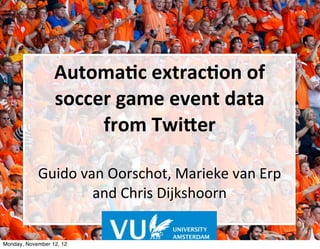
Automatic Extraction of Soccer Game Event Data from Twitter
- 1. Automa'c extrac'on of soccer game event data from Twi6er Guido van Oorschot, Marieke van Erp and Chris Dijkshoorn Monday, November 12, 12
- 2. Soccer data Monday, November 12, 12
- 3. Theory 1. Fair body of research on automated sports highlight extraction 2. Twitter data can offer interesting insights in real world phenomena Monday, November 12, 12
- 4. Automated highlight detec@on Let’s Use Twitter data! Monday, November 12, 12
- 5. 3 Tasks 1. Detecting events What minutes did events occur? 2. Classifying events Is the event a goal, card or substitution? 3. Assigning events to teams Is the event for the home team or away team? Monday, November 12, 12
- 6. 5 types of events - Goal - Own Goal - Red Card - Yellow Card - Substitution Monday, November 12, 12
- 7. Methodology 1. Gathering the data 2. Exploring and cleaning the data 3. Classifying interesting data points Monday, November 12, 12
- 8. Gathering data - Collect all tweets with game hashtags #ajafey #nacgro #psvutr - Collect official data for each match Goals, cards, substitutions Monday, November 12, 12
- 9. Our data 6 months 61 games 661 events 10,643 tweets Monday, November 12, 12
- 10. Three Experiments 1. Detecting events 2. Classifying events 3. Assigning events to teams Monday, November 12, 12
- 11. 1. Detecting events Monday, November 12, 12
- 12. 1. Detecting events Monday, November 12, 12
- 13. 1. Experimental Setup - Goal: detect peaks in # tweets per minute signal to extract events - Setup: Test three peak detection methods: 1. LocMaxNoBaseLineCorr 2. IntThresNoBaseLineCorr 3. IntThresWithBaseLineCorr Monday, November 12, 12
- 14. 1. Results Monday, November 12, 12
- 15. 1. Findings - Goals and red cards are detected better than yellow cards and substitutions - None of the three peak selection methods works well. - Highlights can be extracted, but not precise enough Monday, November 12, 12
- 16. Three Experiments 1. Detecting events 2. Classifying events 3. Assigning events to teams Monday, November 12, 12
- 17. 2. Classifying Events - Goal: Classify minutes into event classes minute “goal” “1” “red” “card” “boring” class 34 0 2 0 1 20 nothing 35 23 34 0 0 0 goal 12 1 2 0 0 5 nothing 13 1 0 22 11 0 red card Monday, November 12, 12
- 18. Issues Problem: Huge, sparse matrix 1. Reduce features Choose words/features smartly 2. Reduce instances Choose minutes smartly Monday, November 12, 12
- 19. 2. Experimental Setup - 3 Instance selection settings 1. AllMinutes 2. PeakMinutes 3. Eventminutes Monday, November 12, 12
- 20. 2. Experimental Setup - 7 Feature selection settings 1. AllMoreThanOnce 2. Top500TotalFreq 3. Top10MinuteFreq 4. Top500TotalTfIdf 5. Top10MinuteTfIdf 6. Top50Infogain 7. Top50GainRatio Monday, November 12, 12
- 21. 2. Experimental Setup - 6 types of classifiers 1. C4.5 2. RandomForest 3. NaiveBayes 4. NaiveBayesMultinomial 5. libSVM 6. IB1 Monday, November 12, 12
- 22. 2. Results Monday, November 12, 12
- 23. 2. Discussion - Top50GainRatio best feature selection - libSVM best classifier - EventMinutes results: Class F-‐measure OVERALL 0.822 Goal 0.841 Own goal 0.000 Red card 0.848 Yellow card 0.785 Subs@tu@on 0.839 Monday, November 12, 12
- 24. Three Experiments 1. Detecting events 2. Classifying events 3. Assigning events to teams Monday, November 12, 12
- 25. 3. Experimental Setup - Goal: Assign events to team - Based on the ratio between tweets from fans for home and away team - But first: extract fans Monday, November 12, 12
- 26. 3. Extracting fans - Hypothesis: People that tweet for the same team each week are probably fan of that team Monday, November 12, 12
- 27. 3. Extracting fans - Extracted 38,527 fans rom 146,326 f users (26%) - This method of extracting fans works well: Right team Not clear Wrong team 88% 10% 2% Monday, November 12, 12
- 28. 3. Results Monday, November 12, 12
- 29. 3. Results - Performance of assigning events to teams above baseline performance: Class Baseline Performance OVERALL 52% 58% Goal 58% 69% Red card 50% 62% Yellow card 63% 63% Subs@tu@on 52% 57% Monday, November 12, 12
- 30. Conclusion 1. Detecting events => difficult 2. Classifying events => good results 3. Assigning events to teams => promising results Monday, November 12, 12
- 31. Future Work - Use sentiment in tweets (for detecting events and assigning events to teams) - Player detection - Other sports Monday, November 12, 12
